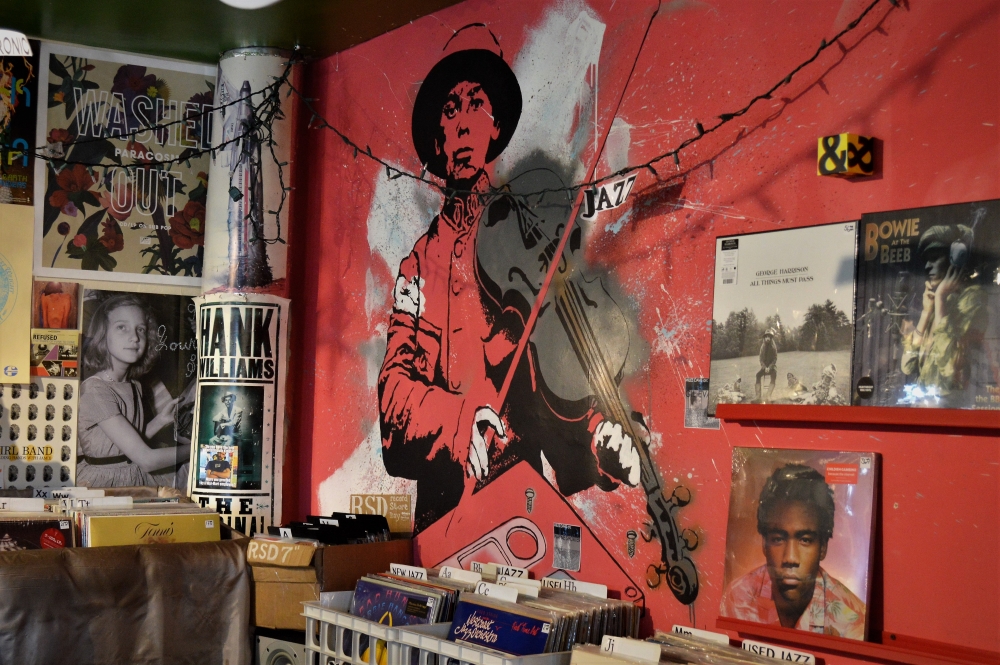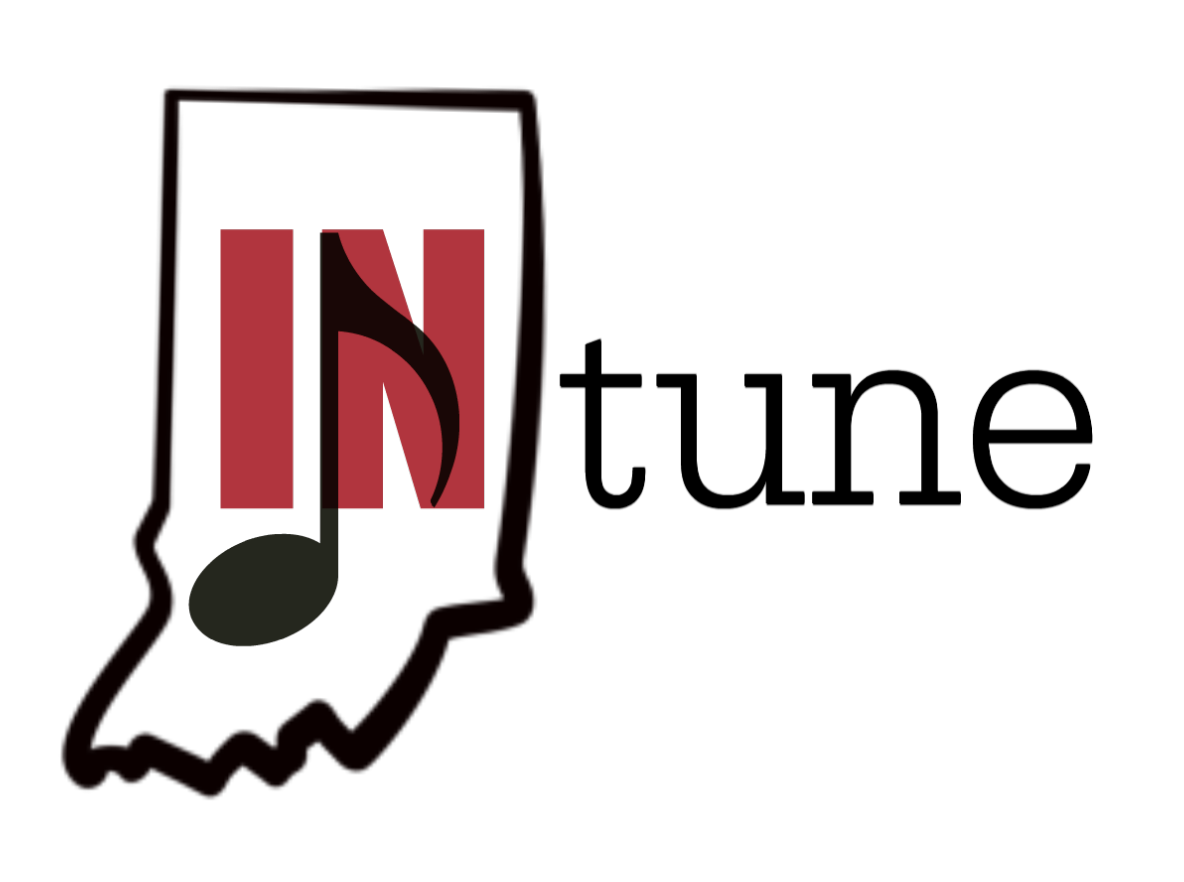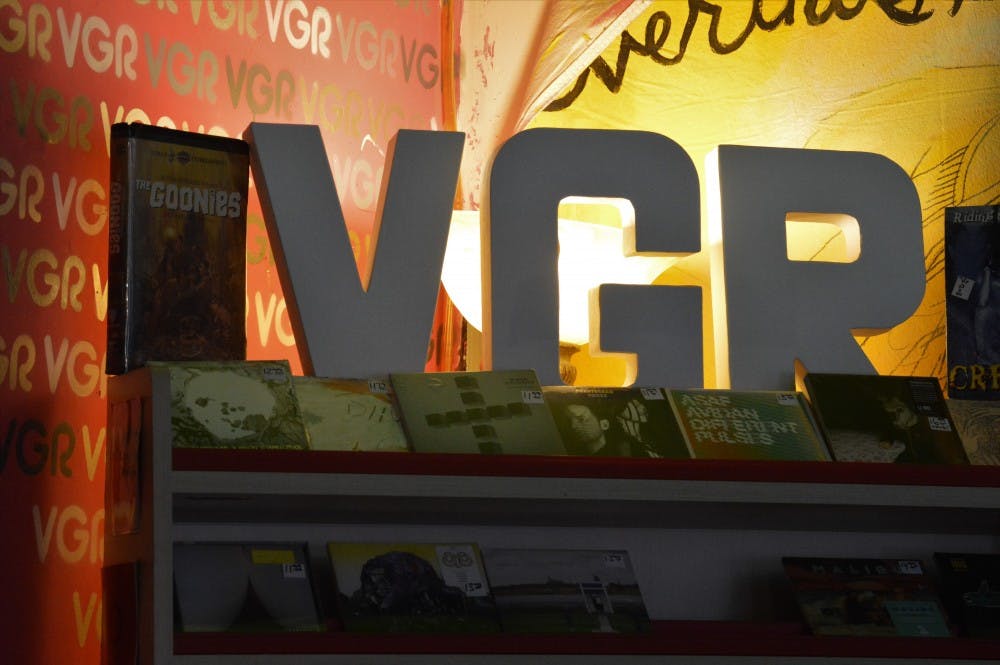The near-campus record store has been a part of the Muncie community for years, serving music loving students and drunken Village wanderers. But despite being right at the edge of campus, on Martin Street and next to Hot Box Pizza, we bet there’s some things you never knew about it.
1.Travis Harvey has owned (and lived inside of) VGR for 10 years.
In 2006, the original owner decided to move on and Travis stepped in and made the place his own — literally. He lives right there in the store with his two cats, Hampton and Boris, and said he spends most of his time there, sometimes 80 hours a week. When Travis took over, he redid it all, keeping nothing but the discounted prices.
2. VGR hosts live music shows and art galleries
As the weather gets warmer, VGR will start to bring more bands to his store’s front lawn for shows. In the past, they’ve hosted more than 150 shows of all different styles. He said bands from all of the world, including Germany, London and Japan have played everything from electronic music, jazz, punk, hardcore and hip hop right on his storefront.
“Some of it’s luck, some of it’s people just wanting to play here,” Travis said. “Some of these groups are nationally known, like The Swirlies ... we’ve done some pretty cool stuff.”
Travis just opened his art gallery space in the back of VGR about 10 months ago, and since hosted three different shows. He said he’s encouraged local artists to display their art, and to keep their prices affordable for students. He’s working on developing a clientele for art and said he’s excited for more shows.
3. VGR has some of the lowest record prices around.
While he also sells CDs, cassettes and more, Travis said when customers come in searching for vinyl records, they’re “sticker shocked” as his prices. At VGR, the records are on average $5 to $10 cheaper, if not more, than at what he calls the typical record store. He even says his prices are the best in the world.
“I’ve never been anywhere that can nearly come close to matching me,” Travis said. “I don’t mean to sound pompous, or like a jerk, I just love getting people prices they can work with.”
He said he makes these lower prices possible by spending time researching and comparing prices of distributors. He also said he only prices his records $3 to $4 higher than what he originally paid for them.
“I’m always trying to find the best price I can for my clientele,” Travis said. “It’s good for me, but most importantly it’s good for my vinyl collecting customers.”
4. Travis painted all of the artwork on the walls and there is a story behind it all.


The painting is inspired by Neutral Milk Hotel’s album, “In the Aeroplane Over the Sea.”Looking at the big picture of all Travis’ artwork on display (including the rainbow-colored ramp found outside), he said he’s attempted to create a nonjudgmental environment that’s sort of carefree, while also recognizing what’s wrong with the world.
5. He once sold an album to the Library of Congress.
He doesn’t even remember what the record was, but it was a (very) old classical album, one of the oldest he’s ever had at the store. Travis said he tried to sell it online and The Library of Congress contacted him about wanting to buy it. He said he received a long and official-looking email from them with intent to purchase it for around $70.
6. His most expensive album ever sold was for $400
While the average rare record might sell at VGR for around $150, Travis once sold a rare Gorillaz album for $400 on Amazon. He said he tried to sell it in his store for only $150, but “nobody bid after two weeks.”
Just last week however, he made his most expensive in store sale at $175 for a box set from the artist Eluvium, which consisted of 6 LPs, a book of canvas artwork and a signed library card.
7. Since his start at VGR, Travis has helped open 4 record stores.
Through networking, Travis has found and been able to assist people open their own stores. Though they’re not his own, he said he loves that he’s had the luck and the opportunity to help others out because he wants to see more record stores open all across America.
“I’ve tried to create a really strong network, that I’ve made on Facebook, of different record store owners and employees and stuff,” he said. “We share business jargon and make fun of awkward interactions. It’s really awesome.”
8. Every album is hand-picked.
While Travis hasn’t listened to every full album but he has for sale, he has at least heard snippets of every one. He does his research on each album to make sure that he can give a recommendation on artists that his customers might like.
“I like to say that every album is hand-picked by myself,” he said. “I’m always trying to go a little deeper and find those special finds.”
Travis even attempts to do this for his customers through VGR’s online presence, like his Instagram and Facebook. He uses the hashtag #VGRBestOf to point his customers toward his best selling music.
He said he enjoys tailoring music to each customer's unique tastes, with a goal of helping them find something new to them that they love and help them be open to both new music and new experiences.
“Before the record store, I was alway that guy that my friends came to for new music, and now I can do that for my customers,” he said.
But It’s not as simple as, “Oh, you like this band? Then you’ll like this band!” Travis said he tries to recommend music to customers based on what they like about certain artists, rather than the artist as a whole.
For example, if you like the band The 1975 because they’re cheery and lighthearted, Travis said he would point you in the direction of the band Tanlines, and their album Mixed Emotions.
9. Travis has his own radio show on WCRD.
Every other week, on Wednesdays, Travis hosts The B-Side Show at 8:30 p.m on Ball State’s radio station. One aspect of his show is a giveaway, where he plays an album and asks his listeners trivia questions about it. Whoever answers correctly wins the album.
10. He co-produced an album testimony series.
Travis said for a long time, he had wanted to shoot a video series highlighting albums that are special to individual people. So with a friend, he shot and edited 50 interviews with people talking about how different music had affected their lives. He said he wanted to include different types of music and different types of people.
“They’re one-of-a-kind, really personal stories that people were willing to go on camera to talk about,” he said. “It’s very simple … it’s not about the bands, it’s about the personal stories. There’s some real emotion, and every story is different. It’s really, really special.”
You can find them here.






